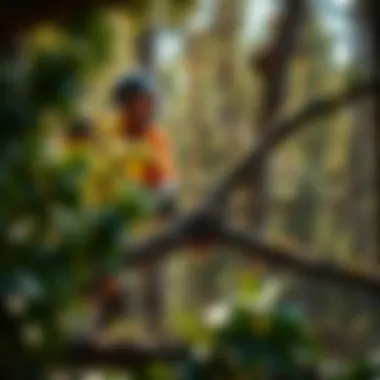When Is It Safe to Trim Trees: A Comprehensive Guide


Intro
Tree trimming is more than just a seasonal chore; it's an essential practice that influences the health, appearance, and longevity of our urban and rural forests. Knowing when and how to trim trees can mean the difference between a vibrant canopy and an ailing one. Trees, like any living organism, require careful consideration when it comes to pruning. Various factors play a role—timing, species, and environmental conditions. Without this understanding, you risk causing more harm than good to these magnificent giants.
In this guide, we will delve into the intricacies of tree trimming. We’ll explore optimal seasons for pruning, how different tree species may require distinct approaches, and the importance of environmental conditions on the safety of trimming operations. A clear grasp of safety protocols will ensure that you are equipped to handle not just the trees, but your own safety as well.
By the end of this comprehensive examination, you will find yourself better informed, whether you are maintaining your yard’s fruit trees or conducting extensive forestry work. Let's embark on this journey to understand when it’s truly safe to trim trees.
Understanding Tree Growth Patterns
When considering tree trimming, understanding tree growth patterns is crucial. This knowledge provides insights into the best times for pruning and helps maintain the tree's overall health and vigor. Trees, like humans, have their own life cycles and patterns of development. Grasping these cycles can make all the difference in how effectively a tree can recover from trimming and continue to thrive. Without this understanding, one risks making rash pruning decisions that could lead to permanent damage.
Biological Growth Cycles
Every tree species exhibits unique biological growth cycles, influenced by factors like genetics and environmental conditions. These cycles generally include periods of rapid growth, tapering, and dormancy.
Rapid Growth Phase: During spring, trees enter a phase of vigorous growth. As temperatures rise and sunlight increases, trees produce new leaves and expand their roots. This is when they are most receptive to light pruning. A light touch is often beneficial here, encouraging further development without hindering growth.
Tapering Growth: Mid-summer often sees trees entering a tapering phase where growth slows. At this time, the tree focuses on solidifying what it has achieved. Pruning during this period requires caution; heavy cuts can stress the tree and lead to issues down the line.
Rest and Recovery: Finally, during autumn and winter, trees focus on conserving energy, retreating into a state of dormancy. This resting period is essential for recovery from the vigorous activities of spring and summer. Anything that disrupts this cycle may compromise the tree's health and growth. Hence, knowing when trees are actively growing versus when they are dormant is a fundamental aspect for successful trimming practices.
Dormancy Periods
Dormancy is a critical phase in a tree’s life cycle, often misunderstood by amateurs. During this time, a tree is not dead – it's simply in a state of preservation. Natural shifts in temperature and daylight trigger dormancy, which helps trees conserve energy and protect themselves from frost damage.
Pruning during dormancy, typically late fall and winter, can be remarkably beneficial. The tree can utilize the energy it saves for healing and growing new branches in the upcoming spring. This is a prime time for trimming larger branches, as the absence of leaves exposes the tree structure, making it easier to evaluate what needs to be removed.
Pruning while the tree is dormant also minimizes the risk of pest infestations and diseases. For many species, any wounds created during this time can heal quickly as the tree prepares for the new growth spurt in spring.
Key Insight: Knowing a tree's growth patterns and dormancy periods is not just practical; it's necessary for sustaining its health and longevity.
In summary, understanding biological growth cycles and dormancy is vital for optimal tree health and successful trimming. Recognizing these patterns allows those involved in tree maintenance to make informed decisions that promote healthy, long-term growth rather than risking harm.
Seasonal Considerations for Tree Trimming
Understanding when to trim trees is crucial, as the timing can greatly affect both the health and aesthetics of the tree. Trees are not just static structures in the landscape; they grow actively, responding to seasonal changes, and their needs shift accordingly. This section dives into the nuances of tree trimming by examining how different seasons impact pruning practices. When executed at the right time, trimming can enhance growth, minimize disease susceptibility, and ensure that trees flourish.
Spring Pruning Advantages
Spring is often heralded as the prime time for pruning deciduous trees. The advantages of spring pruning hinge on several factors that promote vigorous growth. As the sap begins to flow and new buds unfurl, trees are ushered into a rejuvenating phase. This is a window where they can more effectively heal and recover from cuts made during pruning. Key benefits include:
- Enhanced Growth: Cutting back in spring can stimulate new growth as the tree shifts into its active growth phase.
- Easier Visibility: With the absence of leaves in winter, it becomes easier to identify which branches need trimming.
- Disease Prevention: Spring pruning can help eliminate diseased branches before they exacerbate during the growing season, ensuring healthier foliage.
However, some species may not thrive with spring pruning if they bloom early. For instance, flowering trees like cherry and dogwood should be pruned after their blossoms fade to maintain their blooms the following year.
Summer Maintenance Practices
Summer presents an opportunity to maintain the structure of trees through selective trimming. During this time, focus should shift from significant cuts to lighter maintenance practices to encourage healthy growth. Summer pruning can:
- Control Growth: Keeping trees in check prevents them from becoming too dense, which can restrict airflow and sunlight to the inner branches.
- Promote Shaping: Trim back wayward branches to maintain desired shapes without hefty cuts.
- Enhance Flower Production: Pruning midway through summer can encourage some flowering species to produce an abundance of blooms for the following season.


That said, always be mindful of the heat and potential drought conditions that the region may experience during summer. Over-trimming in high heat can stress the tree, making it more susceptible to disease and pests.
Fall Trimming Techniques
As trees prepare for dormancy, fall trimming can be a bit of a double-edged sword. Trimming during this time must be approached with caution. The benefits of fall pruning involve:
- Prevention of Disease Spread: Removing dead or diseased branches before winter sets in can reduce the risks of problems spreading when trees are under stress.
- Aesthetic Pruning: Fall is often when leaves change color and drop, allowing for a clear view of the tree's structure for aesthetic adjustments.
However, it is important to remember that excessive trimming in fall can expose fresh cuts to cold temperatures, which may hinder recovery and invite pests or pathogens. It's advisable to keep fall trimming light and focused mainly on removing any problem areas rather than shaping trees significantly.
Winter Pruning and Its Benefits
Winter is often perceived as the off-season for tree care, yet it offers a unique opportunity for pruning deciduous trees when they are fully dormant. Winter pruning can yield several advantages:
- Easier Access: With the tree devoid of leaves, it becomes easier to navigate and assess its structure.
- Less Stress: Dormant trees can better tolerate pruning as they are in a rest phase, leading to minimal disruption.
- Winter Health Checks: It allows for the identification of any overarching structural issues that might need attention before the spring growth.
However, there's a caveat: Icy conditions and very low temperatures can contribute to injury on exposed cuts, so timing—early to mid-winter—is critical. It's advisable to avoid pruning right before a cold snap, as trees might not effectively heal before exposure.
"Understanding the life of a tree is to grasp that it exists in a rhythm, dictated by seasons and growth cycles. Knowledge of these patterns is key to maintaining its health."
By aligning pruning techniques with these seasonal shifts, caretakers can foster a healthier ecosystem and protect the longevity of trees. Proper timing aids not only in the individual health of trees but also contributes positively to the overall environment where they reside.
Factors Influencing Safe Trimming
Understanding the vital factors that influence safe tree trimming is essential for maintaining healthy trees and promoting their longevity. These factors encapsulate everything from the species of the tree to the environmental conditions surrounding it, and each element plays a distinct role in determining the right approach to pruning. Without considering these aspects, one might inadvertently damage the very plants they intend to nurture and develop.
Tree Species-Specific Guidelines
Deciduous Trees
Deciduous trees are unique in their ability to shed leaves annually, which can significantly impact when and how they should be trimmed. For instance, these trees commonly exhibit robust growth during their active season in spring and summer. Trimming such trees in late winter or early spring before new growth begins is often ideal. This timing minimizes stress as the tree's energy can focus on healing the cuts instead of sustaining foliage. Moreover, since they tend to have a clear dormant season, this unique characteristic allows for seamless recovery post-pruning. However, over-trimming can lead to excessive sap loss which isn’t ideal.
Evergreen Varieties
Evergreen trees, on the other hand, retain their foliage throughout the year, which gives them a distinct trait that requires careful attention. Their growth patterns can differ starkly from deciduous counterparts, making precise trimming time essential. Typically, the recommended time to trim evergreens is in late winter or early spring just before the active growth period begins. These trees possess unique features such as their needle-like leaves that help minimize moisture loss. However, improper trimming can lead to significant aesthetic changes or even invite pests if not conducted properly, which can weaken the tree in various ways.
Flowering Species
Flowering species add a layer of complexity as their pruning needs often hinge on their blooming cycle. Different flowering trees may require trimming at specific times based upon when they bloom. If you trim too late in the growing season, you risk eliminating next year's flowers. These trees can provide a stunning display when properly maintained, but it requires a nuanced understanding of their specific blooming habits. Some flowering species grow best with minimal pruning, while others thrive with it; knowing the characteristic timing of each is key to an attractive and healthy tree.
Health of the Tree
Pest Infestations
Pest infestations pose a real threat to tree health and, consequently, the timing of pruning. Identifying signs of pests early allows for targeted interventions, subsequently making trimming essential in some cases. Regular inspection can help to detect common pests, like aphids or borers, before they cause significant harm. Prompt action in addressing these pests could involve strategic trimming in certain sections of the tree.
Disease Symptoms
Disease symptoms, whether fungal or bacterial, can drastically affect tree health and aesthetics. Recognizing these symptoms is vital as some diseases can spread if not addressed timely. Pruning diseased branches and leaves is not just a trimming task, but a health preservation strategy. A vigilant check for signs of disease can greatly extend the life and vibrance of the tree as it allows you to remove affected areas before the disease spreads further.
Structural Integrity


Structural integrity is pivotal in determining when to trim. Trees grow and mature, which can lead to weak branches that might pose a hazard if left unattended. Regular evaluations of a tree’s structural soundness can help determine if and when certain limbs need attention. Proper trimming can encourage stronger branch structures as well, fortifying the tree against storms or heavy snow loads.
Environmental Conditions
Weather Implications
Weather plays a significant role in the pruning process for trees. Understanding the local climate and seasons is vital in planning effective trimming sessions. For instance, trimming during extreme heat or cold can worryingly stress the tree. Conversely, mild weather creates an ideal scenario for tree pruning, minimizing recovery time and enhancing growth potential.
Soil Moisture Levels
Soil moisture levels can dictate the health of a tree and influence its response to pruning. Trees with adequate moisture levels can cope much better following a trim than those in parched or overly saturated soil. Monitoring the moisture conditions gives a clearer picture of how a tree might respond post-trim. Poor soil conditions can lead to complications during the recovery of trimmed trees, which may severely impact their growth trajectory.
Local Ecosystem Interactions
The health of the surrounding ecosystem significantly affects tree trimming practices. Competitiveness for nutrients, light, and water can vary among tree species and their neighbors. Recognizing this interaction helps guide decisions. Trees that help support their ecosystem can inadvertently influence larger conservation practices, so considering how to integrate trimming practices into broader environmental contexts maximizes benefits for both the trees and their surroundings.
Safety Protocols for Tree Trimming
When it comes to trimming trees, ensuring safety isn't just a good idea; it’s a necessity. Each year, numerous accidents occur due to improper handling of tools or neglecting personal safety protocols. By focusing on key elements such as personal protective equipment, suitable tools, and effective emergency procedures, you can significantly reduce the risks associated with tree trimming. Understanding these protocols is essential for forestry professionals and those who engage in tree maintenance to not only safeguard themselves but also their surroundings.
Personal Protective Equipment
Using the right personal protective equipment (PPE) is the first line of defense against injuries. When trimming trees, it is integral to don proper gear, which can include:
- Safety goggles: Protects your eyes from debris that may be dislodged during trimming work.
- Hard hats: Essential for preventing head injuries from falling branches.
- Gloves: Should be sturdy enough to protect your hands while allowing for good grip on tools.
- Steel-toed boots: They offer protection against heavy falling objects that could crush your feet.
- Hearing protection: Important when working with noisy machinery like chainsaws or chippers.
Wearing appropriate PPE not only minimizes the risk of injury but also promotes a culture of safety in tree maintenance practices.
Tools of the Trade
Selecting the right tools is equally as important as using protective gear. Keeping equipment in good condition can determine the effectiveness and safety of your trimming efforts. Here are some essential tools:
- Pruning shears: For small branches and precise cuts, these should be sharp and well-maintained.
- Loppers: These long-handled tools are ideal for branches that are slightly thicker and out of reach.
- Chainsaws: These are necessary for larger jobs but require careful handling and knowledge for safe operation.
- Rope and harness: Vital for climbing and securing yourself while working at heights.
Always ensure that tools are sharp and clean, as dull instruments can lead to accidents and improper cuts. Regular maintenance checks will extend the longevity of the tools and ensure reliability.
Emergency Procedures
No one expects an accident to happen, but being prepared can save lives. Establishing a clear emergency protocol is essential:
- First aid kit: Have a stocked first aid kit on site, and ensure that all team members know its location.
- Emergency contact list: Always keep a list of emergency contacts, including local hospitals and poison control, prominently displayed.
- Training drills: Regularly hold training sessions to practice emergency responses and ensure that everyone knows how to react in case something goes awry.
- Reporting process: Establish a clear procedure for reporting accidents or near misses to improve safety measures in the future.
Being prepared for the unexpected isn’t just a precaution; it’s a responsibility that fosters a safer work environment and enhances team morale.
These safety protocols set the foundation for effective tree trimming practices. Ignoring them can lead to serious risks not just to yourself but also to those around. Make safety a priority, and your tree trimming endeavors will be much more manageable and less hazardous.
Long-Term Effects of Trimming on Tree Health
Trimming trees is not just a one-off task; it plays a vital role in the ongoing health of a tree over the years. Effective trimming can lead to a myriad of benefits, while poor practices can have dire consequences. Understanding the long-term effects of trimming helps ensure that you keep your trees thriving rather than putting them at risk.
When trees are pruned correctly, you'll often see improvement in their overall vigor and aesthetics. Healthy trees can bolster the environment, enhancing air quality and providing habitats for various species. Additionally, well-maintained trees add character to a landscape and can even increase property value.


People often underestimate the importance of trimming in the long run. Factors such as enhancing light penetration, improving air circulation, and preventing structural defects all contribute to a tree’s resilience. Regular trimming can eliminate crowded areas and encourage proper growth, but it must be executed with care to avoid damage.
“The best time to plant a tree was 20 years ago. The second best time is now.” — Chinese Proverb. This applies to tree trimming as well; ensuring optimal growth now sets the foundation for a flourishing tree in the future.
Indicators of Healthy Growth Post-Pruning
After trimming, certain signs indicate that a tree is responding well to the process. Firstly, observe the new growth; leaf buds should emerge in abundance within the growing season, which provides a clear indicator of robust health. If the tree is a flowering or fruiting species, the presence of blooms or fruits in subsequent seasons is an excellent sign of successful pruning.
The general condition of the tree's bark should also be taken into account. A smooth, blemish-free bark indicates vigour. Conversely, any significant bark damage or peeling can hint at underlying issues. Also, keep an eye out for a symmetrical canopy. If the tree's shape appears balanced and without excessive dead weight on one side, you can be fairly confident that you’ve done a good job with the trimming.
Additionally, conducting health checks, such as inspecting for pests or signs of disease, remains important even after trimming. Ensuring that your tree is not only growing back but also free from infestations or ailments is a crucial step in confirming its overall well-being and longevity.
Common Mistakes to Avoid
While trimming can positively influence a tree’s health, there are several missteps to dodge to get it right.
- Over-pruning: Cutting back too much can weaken a tree, stunting growth and threatening its stability. It’s essential to leave enough foliage for photosynthesis during the critical growth phases.
- Ignoring Tree Species Needs: Different tree species have unique requirements when it comes to trimming. What works well for a maple may not be suitable for an oak. Familiarizing yourself with specific tree needs is a vital step.
- Using Dull Tools: Sharp tools lead to clean cuts that help trees heal faster. Dull equipment may cause jagged wounds, increasing susceptibility to disease.
- Bad Timing: Trimming at the wrong time can stress a tree. For example, doing heavy pruning during their active growth period can be detrimental.
- Neglecting Post-Trimming Care: After trimming, it's important to monitor for pests and maintain adequate watering to help the tree recover well, especially during hot or dry periods.
Understanding these factors can help you avoid common pitfalls and pave the way for flourishing trees that stand tall for years to come.
Professional Tree Services vs. DIY Trimming
Choosing between professional tree services and doing it yourself is like deciding whether to bake a cake from scratch or grab one from the store. Both routes can lead to a tasty outcome, but the journey there is quite different.
When to Hire a Professional
Sometimes the best approach is calling in the experts. Hiring a professional can save time and stress, ensuring the job is done right.
- Complexity of the Job: If the tree in question is large, near power lines, or showing signs of disease, it's wise to consult a pro. They have the necessary skills and experience to navigate tricky scenarios without causing harm—not just to the tree, but also to your property.
- Safety Hazards: Tree trimming is not child’s play. Professionals come equipped with specific tools and protective gear. They understand the risks involved and know how to manage them effectively. A slip with a chainsaw can lead to serious injury—this is where specialized training pays off.
- Insurance Coverage: Reliable tree service companies often carry insurance that protects them (and you) should an accident occur during trimming. Going the DIY route could leave you financially exposed if something goes awry.
- Proper Techniques: Professionals are well-versed in the best pruning techniques, which can improve the tree's long-term health. They know when, where, and how much to cut, minimizing stress and promoting healthy regrowth.
These are compelling reasons why, in certain situations, hiring a professional may be the most prudent choice.
DIY Trimming Considerations
On the flip side, if you're the type who believes in getting your hands dirty, DIY tree trimming might appeal to you. However, it's important to consider several factors before you roll up your sleeves.
- Skill Level: If you've had some experience with gardening or yard work, you might tackle basic trimming tasks. However, be honest with yourself about your skills.
- Tree Size and Species: Smaller and non-complex trees can often be trimmed safely using basic tools. Mix-and-matching between species offers different challenges, some species are very tolerant to heavy pruning, while others require a delicate touch. Knowing these specifics can inform your decision.
- Availability of Tools: If you lack proper tools, or your equipment is outdated, the job may turn out subpar. Sometimes, renting equipment can be a viable option, but that’s an added cost and effort.
- Time Commitment: Trimming trees isn’t merely a quick chore. Evaluate the time you have available. Some trees might need multiple sessions to properly address issues without overdoing it in one go.
"In gardening, as in life, the time you invest yields a harvest. Make sure it's the right kind."
Ultimately, the safety and health of the tree should be your top priority. Whether you hire a professional or choose the DIY path, being informed increases your chances of success in maintaining your green companions.
Epilogue: Balancing Aesthetics and Environmental Health
Final thoughts about trimming trees highlight the fine balance between maintaining the beauty of one's landscape and ensuring the health of the environment. As discussed throughout the guide, tree trimming is not merely a cosmetic endeavor; it's an essential practice for sustaining tree vitality and ecological balance.
The aesthetics brought about by a well-trimmed tree can significantly enhance a property’s appeal. Yet, it’s crucial not to lose sight of the broader implications for environmental health. Over-trimming or improper techniques can jeopardize tree integrity, leading to increased susceptibility to diseases and pests. Healthy trees contribute to cleaner air, reduced erosion, and the overall wellbeing of local wildlife.
Key elements to take into account include:
- Understanding the specific growth habits of different tree species, which demands tailored trimming approaches.
- Being mindful of seasonal variances; for instance, spring might bring new buds while winter trims can prevent damage during snowfalls.
- Recognizing environmental impacts, such as local wildlife habitats that trees provide.
By adhering to safe trimming practices, one can maintain the aesthetic value of trees while nurturing their role in the ecosystem. Emergency measures, safety protocols, and professional guidance are indispensable facets that can inform decisions in this regard.
As environmental considerations become increasingly critical in urban planning and landscaping, the role of tree trimming requires a thoughtful approach. The desire to beautify one’s surroundings should be coupled with an awareness of the ecological ramifications of such actions.
"Pruning the canopy isn't just about cutting branches; it's about nurturing life and preserving the legacy of our environment."















